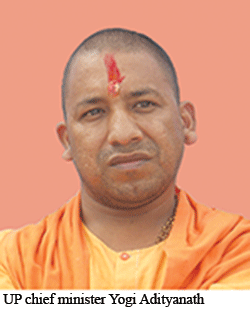 It’s hardly a national secret that the biggest drag on national development are the BIMARU (Bihar, Madhya Pradesh, Rajasthan and Uttar Pradesh) Hindi-belt states of the Indian Union. Among them, Uttar Pradesh — India’s most populous (215 million) state — is commonly believed to be the country’s most lawless and educationally backward, with the possible exception of Bihar. After five years of misrule of the Samajwadi Party — a divide-and-rule, caste-conscious family-dominated political formation — in March the exasperated electorate of UP gave an overwhelming mandate to the BJP, the nationalist hindutva party, to rule UP for the next five years.
It’s hardly a national secret that the biggest drag on national development are the BIMARU (Bihar, Madhya Pradesh, Rajasthan and Uttar Pradesh) Hindi-belt states of the Indian Union. Among them, Uttar Pradesh — India’s most populous (215 million) state — is commonly believed to be the country’s most lawless and educationally backward, with the possible exception of Bihar. After five years of misrule of the Samajwadi Party — a divide-and-rule, caste-conscious family-dominated political formation — in March the exasperated electorate of UP gave an overwhelming mandate to the BJP, the nationalist hindutva party, to rule UP for the next five years.
Following the unexpectedly huge mandate given to BJP in Uttar Pradesh, prime minister Narendra Modi and the BJP leadership unexpectedly appointed Yogi Adityanath, a militant practising Hindu priest as chief minister of UP, ranked #14 on the Educational Development Index of the Delhi-based National University of Educational Planning & Administration (NUEPA). Unsurprisingly, for the past two months UP has been in the news mainly for its cow protection vigilantism, prevention of inter-religious liaisons and marriages and initiatives for constructing a Ram temple on the site of the Babri Masjid, which was razed to the ground by hindutva zealots in 1992.
Against this backdrop, a report of the comptroller and auditor general (CAG) of India, detailing the dismal state of education in this populous state, was tabled in the UP legislative assembly on May 18. Unsurprisingly, the comptroller’s report makes depressing reading.
According to the report, the exodus of children from the state’s famously dysfunctional schools defined by crumbling infrastructure, chronic teacher absenteeism and rock-bottom learning outcomes, shows no signs of abating. The number of students in government primary-secondary schools declined from 19.6 million in 2010-11 to 16.6 million in 2015-16, whereas private school enrolments increased from 12.2 million to 16.7 million. According to the CAG’s calculations, every year from 2010-11 to 2015-16, 2 million children dropped out of the government school system, though District Information System of Education (DISE) data indicates that a mere 630,000 have exited government schools.
The comptroller’s report also makes scathing remarks about the quality of teachers appointed in UP’s government schools. An estimated 30,730 upper primary and 18,119 primary school teachers lack requisite training/qualifications, and there’s a shortage of 175,000 teachers against the sanctioned strength of 760,000.
Castigating the state government for its failure to provide enabling infrastructure, education material and adequately trained teachers to UP’s 19.6 million children in government schools, the report also criticises education officials for negligent implementation of s.12 (1) (c) of the RTE Act under which private schools are obliged to provide free-of-charge class I-VIII education to children from socio-economically underprivileged households in their neighbourhood.
According to the report, in the academic years 2014-15 and 2015-16 only 3,386 s.12 (1) (c) children were admitted into private schools which should have admitted 1.26 million poor neighbourhood children. The cause, as identified by the report, was the state government’s delay in the eligibility notification process and lack of initiative to identify eligible children.
R.P. Singh, principal secretary (Basic Education) of the state government, admits that government schools are engaged in a losing battle against private schools. “We need innovative ways of showcasing government schools which are consistently performing well while bringing laggard schools up to the mark,” he says.
However, informed monitors of primary education in Lucknow are pessimistic about the new state government finding “innovative ways” of upgrading education in India’s most populous state. “Under UP’s yogi (priest) chief minister the focus is likely to be on infusing Hindu mythology and doctored history into school textbooks rather than on teaching modern social and other sciences. Only a die-hard optimist can predict a brighter future for the state’s 45 million unfortunate school-going children,” says a Lucknow University professor, speaking on condition of anonymity.
Quite obviously the comptroller and auditor general of India agrees.
Puja Awasthi (Lucknow)


























